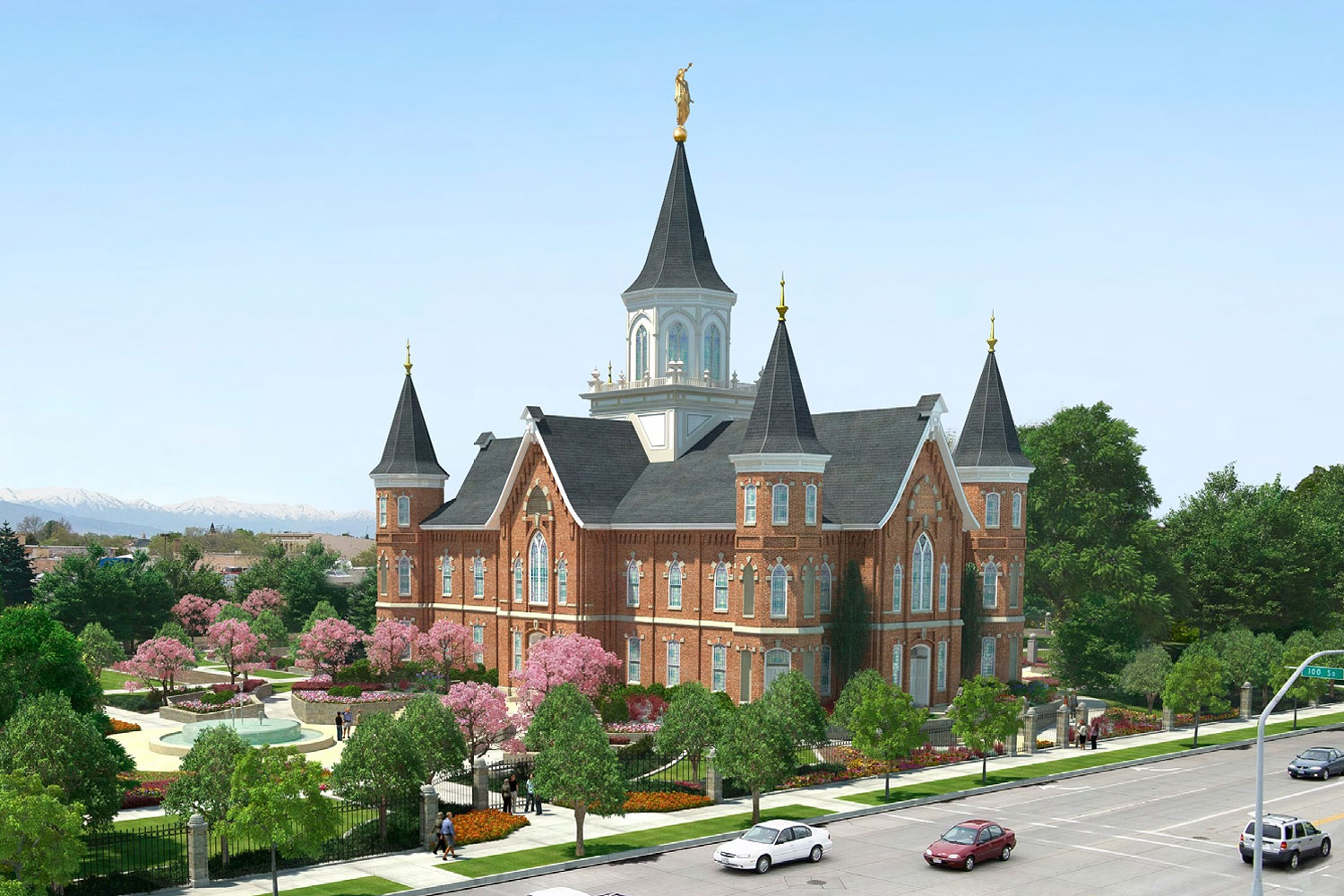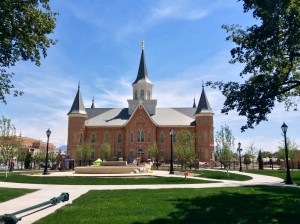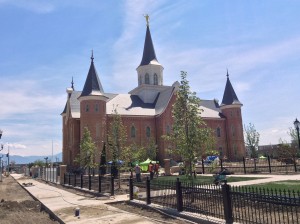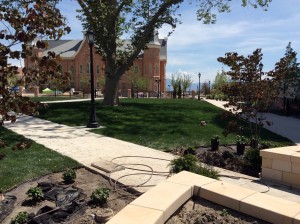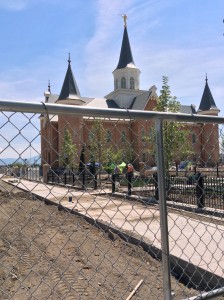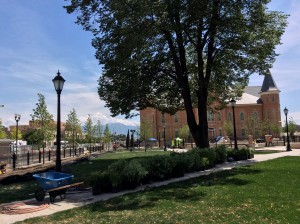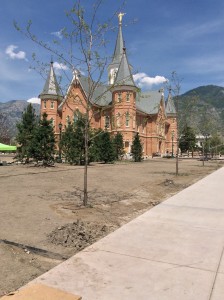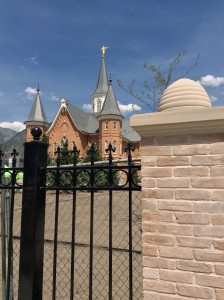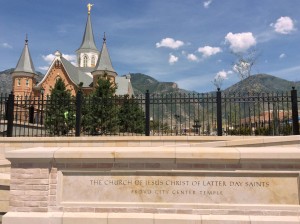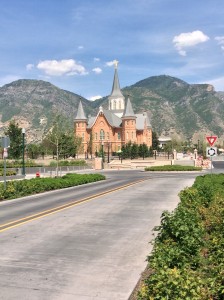Difference between revisions of "Provo City Center Temple"
m |
m |
||
| Line 76: | Line 76: | ||
* [http://ldsmag.com/provo-city-center-temple-a-mighty-change-at-the-heart/ Provo City Center Temple: A Mighty Change at the Heart] by Mariah Proctor | * [http://ldsmag.com/provo-city-center-temple-a-mighty-change-at-the-heart/ Provo City Center Temple: A Mighty Change at the Heart] by Mariah Proctor | ||
| + | |||
| + | * [http://mormontemples.com/4433/mormon-provo-city-center-temple High and Lifted Up – The Mormon Provo City Center Temple] by Keith L. Brown | ||
Revision as of 17:37, 14 November 2015
When a fire tragically gutted the iconic Provo Utah Tabernacle in December 2010, questions immediately arose about what to do with the remains and grounds of the building, which had been a city landmark for more than 100 years. The beautiful structure, built between 1883 and 1898, was venerated by Provo residents and generations of Brigham Young University students who used it for church meetings and concerts.
The early Saints built the Provo Utah Tabernacle to be used as a meeting place. The edifice was dedicated in April 1898 by George Q. Cannon, then serving as a member of the Church's First Presidency. Over 4,000 people were in attendance, both inside and outside the building. President Cannon was accompanied by Joseph F. Smith, John Henry Smith, Heber J. Grant, Reed Smoot and local leader Dr. Karl G. Maeser. The building was used not only to host a few sessions of General Conference (in 1886 and 1887), but also became a venue for over a century of concerts, conferences, graduation ceremonies, and funerals. U.S. President, William H. Taft, visited Utah on 24 - 26 September 1909 and gave an address in the Tabernacle prior to going to Salt Lake City, and Sergei Rachmaninoff filled its hall with his music in 1938.
On 1 October 2011 at the LDS Church’s 181st semi-annual general conference, Prophet Thomas S. Monson announced that the historic building would be remade into a temple. An audible gasp of joy filled the Conference Center.
Patterned after a similar situation with the 1997 dedication of the Vernal Utah Temple, which was built from the Uintah Stake Tabernacle of the early 1900s, this second Provo temple will include a complete restoration of the original exterior design of the Provo Tabernacle.
In recent months, the Church has acquired properties adjacent to the tabernacle. In August 2011, it announced the purchasing of land from two nearby businesses (Travelodge Motel and Los 3 Amigos restaurant). The following month, the Provo Municipal Council passed a vote to sell the Church the land on which the Hotel Roberts stood before it was demolished in 2004. The Church will own the entire block on which the tabernacle stands, with the exception of the property belonging to the U.S. Post Office, and has indicated no plans to pursue ownership of that portion of land.
The original Provo Utah Temple is currently the most-used temple in the world. The nearby Missionary Training Center and campus of Brigham Young University supply the temple with thousands of members eager to do temple work. This second temple will serve to ease the burden placed on the facilities and temple workers of the first, and to reduce wait times.
Contents
- 1 The Historical Value and Significance of Mormon Tabernacles
- 2 Picture Gallery of Provo City Center Temple
- 3 Gazebo on Temple Grounds Gets Copper Roofing
- 4 Open House Announced for Provo City Center Temple
- 5 Temple President Called
- 6 Cultural Celebration and Temple Dedication
- 7 Additional Resources
The Historical Value and Significance of Mormon Tabernacles
Tabernacles built by early members of The Church of Jesus Christ of Latter-day Saints were places of great religious and community significance.
Tabernacles are larger than the tens of thousands of regular Mormon meetinghouses (or chapels) where Latter-day Saints meet weekly for Sunday services. They also differ from temples which are sacred buildings reserved for faithful Latter-day Saints to worship and perform sacred ordinances. Tabernacles are typically used today for meetings with several congregations combined.
Historically, tabernacles have ranged from simple log cabins (Kanesville, Iowa, constructed in 1847) or adobe (mud brick) buildings (the first tabernacle in Salt Lake City, Utah, 1852) to classically inspired temple-like structures (Bountiful, Utah, 1857–63), picturesque Victorian halls (Bear Lake, Idaho, 1884–89, and Provo, Utah, 1883–96), and buildings that hark back to the American colonies (Boise, Idaho, 1924–25). The last tabernacle built by the Church was the Ogden Tabernacle. Of steel and concrete, it features modern international architecture (1952–56).
The restoration of the Provo City Center Tabernacle is attracting many people who want to see history in the making as the pioneer-era landmark is transformed into what Latter-day Saints believe is a “House of the Lord.”
Picture Gallery of Provo City Center Temple
Here are some up to date pictures of the new Provo City Center Temple. All images were downloaded from the 8 July 2015 article by Amy Tanner Thiriot "New Views of the Provo City Center Temple".
Gazebo on Temple Grounds Gets Copper Roofing
On Friday, 10 July 2015, construction workers add a copper roof onto the gazebo at the new Provo City Center Temple. The framework for the 5,290-square-foot, two-story pavilion, located approximately midway between 100 and 200 South, was initially constructed in June 2014. It will serve as a waiting area for non-temple patrons and a place for wedding parties to take pictures, and will connect to the underground parking via elevator.
Open House Announced for Provo City Center Temple
The First Presidency of The Church of Jesus Christ of Latter-day Saints has announced that the open house of the Provo City Center Temple, located on University Avenue between Center Street and 100 South in Provo, Utah will begin in January 2016. The open house is free to the public and starts on Friday, 15 January 2016 and continues through Saturday, 5 March 2016. There will not be an open house on Sunday 17, 24, and 31 January, or 7, 14, 21, and 28 February. Admission is free, but reservations are requested. Those wishing to attend are also asked to dress modestly. Tickets for the open house can be purchased online at tickets.lds.org beginning 4 January 2016 at 10:00 a.m.
The open house tours begin with a short video presentation providing an overview of temples and why they are significant to members of The Church of Jesus Christ of Latter-day Saints. Following the video, a tour host will escort visitors through the temple, explaining the purpose of each room and answering questions as time allows. At the conclusion of the tour, visitors will be invited to a reception area to have any further questions answered.
Temple President Called
Allen Carlsen Ostergar Jr., 73, a local resident, has been called as the first president of the Provo City Center Temple. His wife, Nancy Sigrid Farnsworth Ostergar, will serve as temple matron.
Prior to be called to serve as temple president, Ostergar was serving as a stake president. He has also served in several other leadership capacities in the Church: (1) president of the Louisville Kentucky Mission, (2) president of the Brazil Missionary Training Center, (3) president and bishop of a Young Single Adult Stake, and (4) former administrative director of Missionary Training Centers. He is a graduate of Brigham Young University (BYU). He has a master's degree in public administration; is the recipient of the distinguished Alumni Award from BYU-Idaho; and speaks fluent Portuguese.
His wife, Nancy Ostergar currently serves as a ward choir president. She faithfully served with her husband in Kentucky and Brazil. She has also served as a ward Relief Society president, ward Young Women president, and ward Primary president.
Cultural Celebration and Temple Dedication
On Saturday, 19 March 2016, a cultural celebration will be held commemorating the heritage of the Provo region through narration, song, and dance. The location for the celebration has not yet been announced.
The Provo City Center Temple will be dedicated in three sessions on Sunday, 20 March 2016. The dedicatory sessions are scheduled for 9:00 a.m., 12:00 p.m. and 3:00 p.m. and will be broadcast to Utah meetinghouses. The three-hour block of meetings will be cancelled for that Sunday to allow members to participate in the sacred events.
Appointments for living ordinances can be made beginning Tuesday, 1 December 2015 at 8:00 a.m. Hours for appointments will be 8:00 a.m. until 2:00 p.m. Monday through Friday.The temple will open for ordinance work on Monday, 21 March 2016, by invitation, and on Tuesday, 22 March 2016, for all patrons.
Additional Resources
- Learn more about the Provo City Center Temple
- Provo City Center Temple: A Mighty Change at the Heart by Mariah Proctor
- High and Lifted Up – The Mormon Provo City Center Temple by Keith L. Brown
